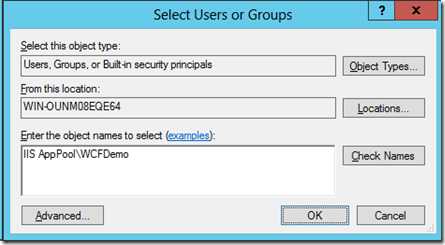使用wsHttpBinding构建Message安全模式和UserName授权
Posted marcocao
tags:
篇首语:本文由小常识网(cha138.com)小编为大家整理,主要介绍了使用wsHttpBinding构建Message安全模式和UserName授权相关的知识,希望对你有一定的参考价值。
http://www.cnblogs.com/artech/archive/2011/05/22/authentication_01.html
https://www.cnblogs.com/Frank-yafeya/p/3283699.html
https://www.cnblogs.com/jfzhu/p/4067873.html
https://www.cnblogs.com/niaowo/p/4727378.html
1. server
a. implement UserNaePasswordValidator
using System; using System.Collections.Generic; using System.Linq; using System.Web; using System.IdentityModel.Selectors; using System.ServiceModel; namespace WcfService1.Common { public class CustomUserNameValidator : UserNamePasswordValidator { public override void Validate(string userName, string password) { if (userName != "admin" || password != "abc123") { throw new FaultException("UserName or Password is incorrect!"); } } } }
b. generate certificate
makecert.exe -sr LocalMachine -ss My -a sha1 -n CN=WcfServerCert -sky exchange –pe
c. config
<?xml version="1.0"?> <configuration> <appSettings> <add key="aspnet:UseTaskFriendlySynchronizationContext" value="true" /> </appSettings> <system.web> <compilation debug="true" targetFramework="4.7" /> <httpRuntime targetFramework="4.7"/> </system.web> <system.serviceModel> <services> <service name="WcfService1.Service1" behaviorConfiguration="securityBehaviorConfig"> <endpoint address="" binding="wsHttpBinding" contract="WcfService1.Contract.IService1" bindingConfiguration="wsBindingConfig" /> <host> <baseAddresses> <add baseAddress="http://localhost/wcf/Service1" /> </baseAddresses> </host> </service> <service name="WcfService1.UserService"> <endpoint address="" behaviorConfiguration="WcfService1.UserServiceAspNetAjaxBehavior" binding="webHttpBinding" contract="WcfService1.UserService" /> </service> </services> <behaviors> <endpointBehaviors> <behavior name="WcfService1.UserServiceAspNetAjaxBehavior"> <webHttp /> </behavior> </endpointBehaviors> <serviceBehaviors> <behavior> <serviceMetadata httpGetEnabled="true" httpsGetEnabled="true" /> <serviceDebug includeExceptionDetailInFaults="true" /> </behavior> <behavior name="securityBehaviorConfig"> <serviceMetadata httpGetEnabled="true" httpsGetEnabled="true" /> <serviceDebug includeExceptionDetailInFaults="true" /> <serviceCredentials> <serviceCertificate findValue="WcfServerCert" x509FindType="FindBySubjectName" storeLocation="LocalMachine" storeName="My"/> <userNameAuthentication userNamePasswordValidationMode="Custom" customUserNamePasswordValidatorType="WcfService1.Common.CustomUserNameValidator, WcfService1"/> </serviceCredentials> </behavior> </serviceBehaviors> </behaviors> <bindings> <wsHttpBinding> <binding name="wsBindingConfig"> <security mode="Message"> <message clientCredentialType="UserName" /> </security> </binding> </wsHttpBinding> </bindings> <protocolMapping> <add binding="basicHttpsBinding" scheme="https" /> </protocolMapping> <serviceHostingEnvironment aspNetCompatibilityEnabled="true" multipleSiteBindingsEnabled="true" /> </system.serviceModel> <system.webServer> <modules runAllManagedModulesForAllRequests="true"/> <!-- To browse web app root directory during debugging, set the value below to true. Set to false before deployment to avoid disclosing web app folder information. --> <directoryBrowse enabled="true"/> </system.webServer> <system.diagnostics> <sources> <source name="System.ServiceModel" switchValue="Information, ActivityTracing" propagateActivity="true" > <listeners> <add name="xml"/> </listeners> </source> <source name="System.ServiceModel.MessageLogging"> <listeners> <add name="xml"/> </listeners> </source> <source name="myUserTraceSource" switchValue="Information, ActivityTracing"> <listeners> <add name="xml"/> </listeners> </source> </sources> <sharedListeners> <add name="xml" type="System.Diagnostics.XmlWriterTraceListener" initializeData="Error.svclog" /> </sharedListeners> </system.diagnostics> </configuration>
certlm.msc 添加 IIS AppPoolAppPoolName帐号,替换AppPoolName为应用池的名称,这里为WCFDemo。

2. client
var wsBinding = new WSHttpBinding(); wsBinding.Security.Mode = SecurityMode.Message; wsBinding.Security.Message.ClientCredentialType = MessageCredentialType.UserName;
// for exception: Identity check failed for outgoing message. The expected DNS identity of the remote endpoint was ‘localhost‘ but the remote endpoint provided DNS EndpointIdentity identity = EndpointIdentity.CreateDnsIdentity("WcfServerCert"); EndpointAddress endAddress = new EndpointAddress(new Uri("http://localhost/wcf/Service1.svc"), identity); using (var factory = new ChannelFactory<IService1>(wsBinding, endAddress)) { factory.Credentials.UserName.UserName = "admin"; factory.Credentials.UserName.Password = "abc123"; factory.Credentials.ServiceCertificate.Authentication.CertificateValidationMode = X509CertificateValidationMode.None; var proxy = factory.CreateChannel(); string result = proxy.GetData(8); Console.WriteLine(result); }
以上是关于使用wsHttpBinding构建Message安全模式和UserName授权的主要内容,如果未能解决你的问题,请参考以下文章
使用 wshttpbinding 的 WCF 用户名和密码验证不起作用
尝试将 gSoap 与 WCF 和 WSHttpBinding 一起使用